
BRITISH COLUMBIA

Vancouver
NO PART OF THE FOLLOWING
ARTICLE AND PHOTOGRAPHS
MAY BE REPRODUCED WITHOUT
PERMISSION FROM THE AUTHOR ©
(Also referred to as
"Hastings Park" and "Exhibition Park")
|
Happyland was so closely associated with the Vancouver Exhibition (now Pacific National Exhibition), that it's hard to give the history of one without the other. Therefore, this article will discuss both, but with emphasis on the amusements as is in keeping with this website's interests. This will only be addressed up until the demise of Happyland in 1957. If you wish to learn more about the exhibition itself, see the CEC's Fairs Books section. Although the name "Happyland" did not come into use until later, there were attractions on the property for some time beforehand. As well, some of the fair buildings and facilities were available to Happyland outside of exhibition times. So for the purpose of this article they will be considered part of this park. Note too, that some of the attractions discussed below were one-time setups and specifically for the fair. Again, for the purposes of this article they will be considered part of Happyland's attractions. |
What was to become Happyland was situated on land donated by the Province of British Columbia in 1889. This land was on the north shore of the township of Hastings and was called Hastings Park, of which a portion still exists today. There were large stands of trees, open areas, water frontage on Burrard Inlet, and a ravine running through the area with a small stream at its bottom. The park was used for livestock sales or shows as early as the 1890s and there were a few small buildings erected to support that purpose.
One of the first major permanent facilities was a racetrack that was operating by at least 1905. It was a bare-bones setup with a fenced-in, oval, dirt track. There was one small two-story tower for race officials and a clock with manually-set hands to indicate the start of the next race. A board shown in one photo on a stand next to the tower may have indicated the horse/race statistics and possibly betting odds. The racetrack drew respectable numbers, but they were smaller than they could have been because of the distance from the city's core and the difficulty getting there.
In 1907, a group of Vancouver businessmen gathered with the idea to promote the city by operating a fair, even though nearby New Westminster had been running one since 1869. The Vancouver Exhibition Association (VEA) was born and held preliminary meetings to choose a site for fair grounds. They wanted to encourage the development of the city's east end and so preferred grounds with facilities that could be used all season long for other purposes, not just at exhibition time. The Hastings Park area by the racetrack was chosen and they set about securing it. After two years of fund-raising, getting government approval, and then securing exhibitors and entertainment, they were ready.
For 1910, facilities constructed included an athletic field in the center of the racetrack, a 10,000-seat grandstand for both the field and track (which housed the VEA offices underneath), and an Industrial Building with four towers and a glass half-dome on each end. Also built was Machinery Hall, which was later renamed as the "Manufacturers' Building". By 1919 it would house the Transportation exhibits. A large garden was planted by Royal Nurseries to dress up the grounds, competitions were organized, and displays prepared.
Transport was established to move prospective patrons to & from the new grounds through B.C. Electric Railway, which was prompted to extend streetcar tracks to the exhibition grounds, and through ferry transport, which went to a newly built pier and dock at nearby Brighton Beach. Canadian Pacific Railway also ran trains from Vancouver to the McGill Street station.
|
Streetcars are shown on Renfrew Street.
In the background is The Industrial
Building. Note the passengers hanging
on to the outside of the tram at the
left and the carnival tents at Center
Left background.
|
B.C. Electric Railway Trams 1910 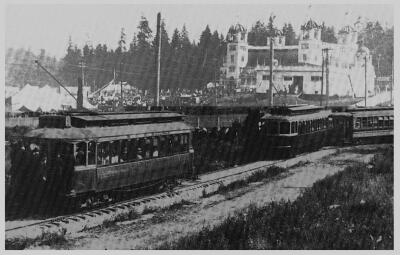 |
|
Industrial Building 1910 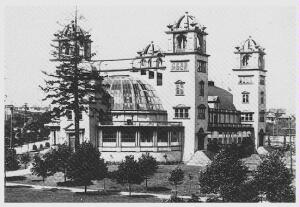
|
Here is a closer shot of
The Industrial Building.
|
Opening day events on August 15th featured a boy scout jamboree and were officiated by Sir Robert Powell at ceremonies held at the racetrack grandstand. The next day, 5000 people showed up for the official opening over which Prime Minister Sir Wilfred Laurier presided.
At 50 cents a head, the fair drew 68,000 persons over six days to attractions such as dog, horse, and poultry shows, and agricultural and art displays. A retail and industrial trade show rounded out the exhibits. Entertainment provided was in the form of band concerts, dancers, vaudeville and plantation shows, plus wrestling and horse/harness racing competitions. The Plantation Show was likely a minstrel-style performance with white performers in blackface makeup.
An amusement midway was set up by a contracted carnival company which may have been Western Shows. It can be seen in later photos of the exhibition. This area was on the northwest side of the grounds next to the racetrack, a space that would eventually be occupied by Happyland.
The midway was called "Skid Road" and had a dunk tank, "Educated Horse", "Egyptian Queen", "Foolish House" (likely a funhouse), a Ganges River crocodile, "Maze Mystery", a petrified woman, something called "Push House", snake charmers, and The Spanish Theatre. There were burlesque shows, Dutch comedians, Oriental dancers, Salome dancers, and Spanish Carmens. Added to that were candy, cigar, lemonade, palmistry, and knife rack concessions, games, a carousel and additional rides.
| In this shot are a ferris wheel, one or perhaps two carousels, games and merchandise tents, and side shows. The racetrack may be seen in the background. |
Exhibition Midway 1914 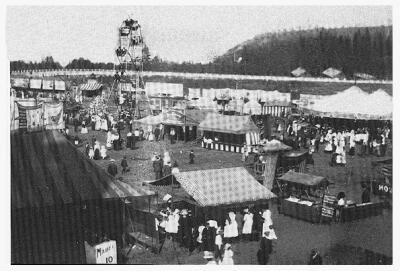
|
We must now pause to discuss two discrepancies regarding rides. One source says that this park had a roller coaster and "Shoot the Chutes" rides before the 1910 season. Apparently, in 1906, Fred Ingersoll and John Miller were supposed to have built a roller coaster there called The "Figure 8". These were very popular around the turn of that century and for a decade or two afterward -- many Canadian parks of the time had one. However, this is now suspect because no other reference has surfaced to this or The "Chutes" ride being there for this time, nor does either show up in any description of the opening season. As well, with few people coming to the area before the advent of the exhibition, there isn't much likelihood of either ride being a money-maker. Therefore, either the "Figure 8" didn't exist or it came afterwards, perhaps in 1911. Even then, it never shows up in pictures for any year this park was operating.
Another possibility is regarding Happyland Park in Winnipeg having an Ingersoll/Miller "Figure 8". It opened in 1906. Given that the two parks have the same name and that both rides are shown opening in the same year, this may be from where the mix-up originates. Research continues, but at this point, it now seems very doubtful that any roller coaster, let alone a "Figure 8", was at the Vancouver Exhibition that early.
The "Shoot the Chutes" ride presents less of a discrepancy. A source says this ride operated earlier than the first season, but although this now seems unlikely, it was definitely in the park by the mid 1920s because pictures prove it. Its opening year is in contention, not its existence.
Although both "Figure 8" and "Shoot the Chutes" rides were on the market in the 19-0s, the source is clearly wrong here, in that The "Chutes" ride is not indicated on a 1915 map of the park, nor can it be seen in the 1919 aerial photograph, farther on. It does show up in a photo with a Traver "Missouri Mule" ride (discussed later), and with The "Giant Dipper" roller coaster, which would be built in 1925. The earliest a park could even receive a "Mule" ride would be late 1926 (its year of introduction), or early in 1927. Photos of this may be seen later in this article.
Thus, The "Chutes" ride appears to have been installed in the park between 1920 and 1927. As discussed below, the VEA wanted to have a permanent midway and seems to have begun this in 1925. Given that The "Giant Dipper" was installed that year, and that it and The "Chutes" ride were both designed by Fred Church, 1925 is the most likely year for The "Chutes" installation. Another possibility that would explain these discrepancies is that the rides were there, removed, and then returned/rebuilt, but this is highly unlikely because of the cost to do so and the complexity of their structures.
Getting back to the exhibition, the opening-year fair was a great success. Each season it grew with larger displays and additional permanent structures. These would include a new Manufacturers' building and one for Forestry.
Despite the outbreak of The Great War in 1914, the Vancouver Exhibition continued. The grounds became a place for military mobilization and a location for patriotic events designed to promote Canada's war involvement. The large area of cleared ground was perfect for encampment, training and drill exercises.
Items seen for 1914 include the Vancouver General Hospital Tent and The Better Babies Contest. The Hospital Tent promoted personal hygiene and medical care while the contest was a method used to get mothers to bring their babies in for a medical check. Prizes were awarded for the healthiest baby, while those found to be ill were sent to hospital. In the 1930s, The Vancouver Health League would mount similar displays at the fair.
On the midway, a 12-tub ferris wheel (likely Eli Bridge) is shown in one photo (seen farther back) along with a carousel, and game and side show tents.
Auto racing was presented on the racetrack starting sometime in the mid 1910s. It would last into the 1930s. Also, the airplane was often a feature around this time both in static and air displays. Later, aviation companies even offered flying lessons.
By 1915, a map of the fair shows the following attractions and facilities:
Aquarium
Athletic Field (1910)
Band Stand
Bank
Birds and Pet Stock
Blacksmith
Carousel
Cat Building
Cattle Stables
Dairy
Dining Hall
Directors' Dining Room
District Display Exhibit
Dog Building
Educational Exhibits
Feed Store
Ferryboat Wharf (1910)
Fine Arts Display
Fireworks
Forestry Building (1913)
Fountain
Free Paddock
Fruit Display
Grandstand (1910)
Green House
Horse Stables
Horticultural Building
Industrial Building (1910)
Lovers' Walk (Forested Path bounded by the
Picnic Grounds and Ravine.)
Manufacturers' Building
Mineral Exhibit
Miniature Railway (to become Happyland Railroad?)
Parcel Check
Pay Telephone
Picnic Grounds
Playground
Post Office
Poultry Building
Press Bureau
Race Track and Stables (Around 1905.)
Racing Paddock
Refreshment Stands
Roller Coaster ("Dip the Dips" - 1915. See below.)
Sheep Stables
Shrubbery Display
Skid Road (Midway) (1910)
Stable Restaurant
Stock Judging Building
Streetcar Station (1910)
Swine Stable
Telephone Exchange
Transportation Building (was the Manufacturers' Building)
Vaudeville Stage
Vegetable Displays
Women's Work Display
Zoo
It's not clear how much of this was permanent, but judging by the map, it all was, save for the portable midway rides and attractions. Several proposed buildings are also shown on the map.
The "Figure 8" coaster (if it existed) would have only lasted until 1915. It is not shown on the map, but another coaster is. Built that year was The "Dip the Dips". It incorporated a figure 8 within its layout, but as a finale, rather than just being the whole ride. Leading up to that, were three turnarounds with steeper drops and more thrills than a typical "Figure 8".
|
Dip the Dips
1918 
Here is a fuzzy photo of the coaster taken only three years after its construction. The small pointed roof building at Center Left is likely a ticket booth for the ride. The purpose of the structure to its right is unknown. It may be part of the station, but perhaps is a maintenance building. The path at the left leads to Renfrew Street and the streetcar line. |
This design is the one depicted on the 1915 map of the park. It's possible that the source which showed a 1906 "Figure 8" coaster may have confused the two, but it doesn't explain why it thought a coaster was in the park before the exhibition had its first year. A clue regarding this is the fact that another Vancouver park, White City, had a "Figure 8" installed in 1916. Perhaps there *was* one at Happyland and it was moved there to make way for "Dip the Dips".
The "Dips" may have been designed by Fred Ingersoll and/or John Miller. It started out of the station making a left turn, and crossed the layout to the lift hill. Off the lift, the ride went into a 180-degree turnaround which then dropped and went over top of the station to another drop and then to the far-end 180-degree turnaround. It next dropped a few times and followed the first turnaround but at a lower level. At this point it entered the figure 8 with a double down, up over the cross-over, another dip, up to a banked, right turn that followed the second turnaround, but in the opposite direction and again, at a lower level. Then there was another double-down, a hill, under the cross-over, and finally a long, left curve returned riders to the station.
|
Dip the Dips
1923 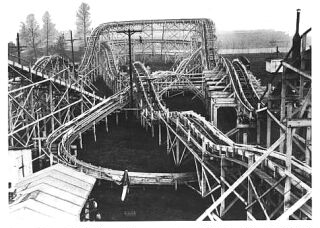 (Vancouver Public Library Photo #12261) |
This depicts the layout of the ride. The station is at the right and lift hill to the left going up out of frame. Note at Upper Right a white building not seen in the previous photo. |
Despite competition from New Westminster's Fair, a dip in attendance and contest entrants, and the presence of the military, which were using the grounds for training, the Vancouver Exhibition did well through the Great War period. No new attractions are listed for any combat years after 1915, but much advertising was done for the war cause, and presumably the fair made up for some loss of business through soldiers' attendance. They then began improvements after the war ended.
|
Exhibition Grounds from the Air 1919 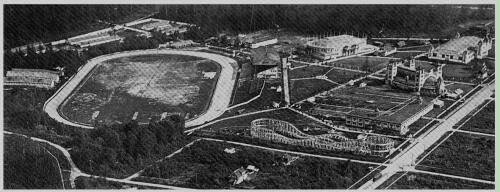
Seen here are The Dips coaster and the racetrack with its grandstand. Beyond the coaster looking to Upper Right are the Manufacturers' Building before the wing was added, the Industrial Building, the Transportation Building (which had previously housed the Manufacturers' exhibits), and Forestry Hall. The other large building just past the grandstand is the Livestock Judging Pavilion. |
In 1920 or 21, the main entrance was moved closer to Hastings Street because of that street's widening and paving in 1920. A later photo from 1929 (seen below) shows this entrance. Above it is a large sign reading "Exhibition and Happyland", with "Vancouver Exhibition Association" and "Vancouver Exhibition Grounds" on plain painted boards underneath. It's unclear if the title "Happyland" began to be used as a name for the midway by the early 1920s or not. As discussed later, it appears to have been used from about 1925 or so.
|
Happyland Entrance 1929 
This is the Happyland and Exhibition Front Gate at the new location closer to Hastings Street. |
Through the 1920s, attendance increased and prize monies were bettered. Previously, draws for automobiles, cash, or world trips occurred, but it was the house give-aways that impressed most. These started during this decade and lasted beyond the demise of Happyland. A home would be temporally erected on the grounds for people to inspect and on which to buy tickets. At the end of The Exhibition, it would be given away.
Despite the increase in numbers, problems did arise. The fair's lease of Hastings Park came under scrutiny several times when controversy arose regarding The Vancouver Exhibition Association's role over, and control of, the fair and its grounds. It was suggested that a merge between New Westminster's mostly agricultural fair and Vancouver's mostly industrial fair might be appropriate. This was entertained by both parties, but New Westminster wanted the coalition to be at some location other than either of the then-current sites. However, the VEA would only unite the fairs if New Westminster agreed to close theirs and move to Hastings Park. New Westminster declined.
Another problem was that Vancouver Council wanted some say in the running of the annual exhibition and what else the grounds might be used for. This came to a head in 1925 but was stemmed when the directors' board threatened to resign if they did not have full control over the fair. Conversely, the VEA also saw the possibility of eventually losing their status and realized that it needed to bend to public will if it was to continue as it had been.
They needed to make their grounds accessible and usable for the entire summer season and proceeded to install an 18-hole golf course to mate with an automobile campground and gas station that was constructed as part of the VEA's 1923 lease. This ground proved popular only for a short period and was likely gone soon after the 1929 Stock Market Crash, a time when few could afford to run their cars.
To further appease the city council, the exhibition buildings were made available for rent to companies wishing a venue for meetings and conventions. An example of off-season use is the horse show building, which was set up for indoor tennis. Over the succeeding years, other buildings were expanded such as The Manufacturers' Building, to which was added an additional wing, making it `U' shaped.
A season-long midway was opened with permanent attractions. This midway was operated under the B.C. Amusement Company banner and became known as "Happyland", but the exact date the name began to be used has not yet surfaced. Indications are for sometime between 1925 and 1929 where a photo (seen previously) shows the name at the exhibition entrance, but it could have been used loosely as early as 1920.
One of the first of these permanent attractions would be a new coaster. In 1925 The "Dips" coaster was removed, perhaps to be sold to White City, which acquired a "Dips" coaster in 1926. In almost the same location, a Prior & Church "Giant Dipper" coaster was constructed. (Some sources for The "Dipper" give 1927/28, but this is wrong, and is likely confused with The "Baby Dipper", which opened in 1928.)
The "Giant Dipper" cost $65,000, was supposedly 1500 metres long and had trains consisting of 10 two-passenger, trailered cars with open fronts. Later photos show 8-car trains, so they may have shortened the trains due to higher maintenance costs and reduced revenue during the Depression. Then two, it would give them spare cars.
|
Here is a hand-tinted postcard view.
At Center Bottom is the run-out pond
for the "Shoot-the-Chutes". Note the
attendants with pikes guiding the boats
to the unload area, which is out of frame,
right. Between that and the coaster structure lies an open rectangular area which would sport a Missouri Mule ride within a season or so. |
Giant Dipper Roller Coaster circa 1925 - 27 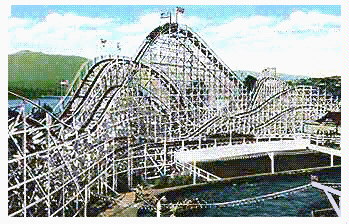 The front four-fifths of the train has crested the lift and begun its descent down the first drop. |
Early research shows that the "Dipper" supposedly had an 18-metre drop and a top speed of 64 km/h. This does not quite work out because an 18 metre drop should return a top speed of 68 km/h. Since a 64 km/h speed works out to be a drop of 16.1 metres, perhaps the 18-metre figure was the total height of the ride, not the drop height. On the other hand, the 4 kilometre per hour loss could be due to friction and wind resistance. However, the photo below shows that the first drop did not reach ground level, so the 18-metre figure may indeed be the total height.
|
Giant Dipper Roller Coaster Mid to Late 1920s  (Vancouver Public Library Photo #11690) This shot was taken from behind the coaster. It shows the first drop and turn-around, plus the second turn-around at Center Left, as well as the lower trackwork on the slope going toward the racetrack. |
Another descrepancy in the statistics of this ride was introduced by coaster enthusiast Tyler Eaves of Greenville, North Carolina. He feels that a lift height of under 20 metres is too short for a ride length of 1500 metres. Tyler notes that a count of the structure's levels indicates a height of perhaps 31 to 35 metres, which is more in keeping with a ride of that length. 35 metres would return a frictionless top speed of about 94 km/h. However, given that the first drop does not go to ground level would reduce this. His estimate from photos is that the drop bottoms out at 3 to 5 metres above ground level. Taking the highest values from above gives a drop of 30 metres for a frictionless speed of 87 km/h. That is about 36% faster than indicated in a newspaper article of the time. Research continues.
UPDATE: Contributor Harold Garmonsway of Wellington, New Zealand
has seen blueprints of this coaster. They and related items are
stored at the Vancouver Public Library. He says: There are 16
blueprints in all which show the profile diagram and a horizontal
plan, and diagrams for building the trains, subtrack, station,
and lift. Two banking diagrams are included, as well as a
blueprint for the earlier "Dip the Dips".The ride was designed by Fred Church in March 1925. The
blueprints show it was exactly 22.86 metres high with a first
drop of exactly 21.34 metres, and a total track length of exactly
1066.8 metres. Note though, that the ground under the coaster
was not level but sloped downward toward the racetrack.So the drop, as stated by Harold, returns a frictionless speed of 73.6 km/h. I feel the ground slope is not relevant here because the additional ground support lengths on the slope would keep the structure regular and level. Ignoring these extra supports on the slope and looking only at the horizontal woodwork between the top of the lift hill and the bottom of the drop, there appear to be 14 levels. Multiplying this by 1.52 metres (five feet) per level gives 21.28 metres of drop. The 1.52 metres is a comfortable working height per level, and this spacing is reflected on the drawings. Thus the result tallies with the blueprints.
The "Giant Dipper" measurement issues are now resolved.
|
Giant Dipper Lift Hill circa 1925 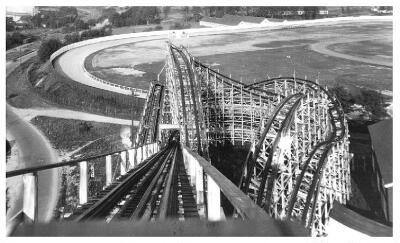 (Vancouver Public Library Photo #12276) This view is looking over the back seat of the coaster train towards the bottom of the lift hill. At Bottom Right is the coaster's station, and at the extreme Bottom Right is the tunnel leading from the station through the structure to the bottom of the lift hill. In the background lies the park's race track. The purpose of the three peaked-roof buildings just beyond it are unknown, but they may have been stables for the horses. |
By 1936, the coaster had been neglected due to lack of funds during The Depression, but $2000 was apparently allotted to make temporary repairs. They did not last long, for in 1939, $5000 was the estimated cost to reconstruct The "Dipper" (I assume that "reconstruct" did not mean the coaster would be completely disassembled and rebuilt, but meant it would be retracked.) Interestingly, a year later in 1940, a newspaper ran a story that $5000 was needed for repairs. This seems unusual, so I assume that the retracking had not been done the year before.
This coaster would run throughout the 1930s and 40s until the end of the 1947 season, save for the World War II break from 1942 through 1946, inclusive. In early 1948, it would be removed in order to enlarge the racetrack.
1925 may have been the year The "Shoot the Chutes" ride went in, as well. It was located right next to the new coaster and appears in photos taken in the mid and late 1920s. However, for reasons discussed earlier, there is a possibility it may have already been operating when the "Dipper" was built. Then again, considering this was the real start of the permanent midway, despite some fixed attractions beforehand, and that no "Chutes" ride is indicated on the 1915 map, 1925 is a very likely year for this ride to have first run.
|
Shoot the Chutes Giant Dipper 1941 
Here is a foggy-day photo taken from the roof of a nearby building. Prominent is the Chutes structure. Note what appears to be a water tower at the top. Presumably it provided water for the down run of the boats. In the background is the Giant Dipper. At Center Left is part of the U-shaped Manufacturers' Building. In front of it is the carousel building. On its roof, facing left, is a sign: "Amusement Area". In front and to the left of that is what appears to be a "Chair-O-Plane". An adult ferris wheel is seen, and peeking through the trees to its right is a kiddie ferris wheel and what may be a smaller "Chair-O-Plane". |
Two other items mentioned as having been built after the VEA decided to expand the season, are an aquarium and a zoo. However, both are shown on a 1915 map of the park and thus either this information is wrong or perhaps both were expanded or replaced at this time.
There was also a "Baby Dipper" coaster at the park. Built by The Philadelphia Toboggan Company, it ran from 1928 until 1944 when it was torn down to make way for military encampments and parking due to yet another world war. The design is attributed to Herb Schmeck. He planned many PTC coasters at that time, but in this case, there is some controversy due to the fact that Herb's initials do not appear on the blueprints for The "Baby Dipper".
|
In this compressed-distance telephoto shot, The Industrial Building with its glass half-domes at each end, may be seen behind the coaster. |
Baby Dipper
Roller Coaster late 1928 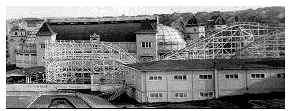 In the foreground is another part of the U-shaped Manufacturers' Building. To its left on the fence are signs for The Greyhound Racer and The Happyland Railroad. The Baby Dipper station is under the peaked roof at Center Left. The track at Lower Left is for The Greyhound Racer, likely a go-kart type of auto ride. |
|
Baby Dipper
Roller Coaster 1930s 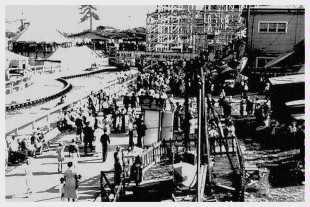 |
Here is a shot of the same area taken later in time and closer to ground level. The ride in the foreground appears to be a Loop-O-Plane or a precursor to it. |
As previously mentioned, there was a "Missouri Mule" ride operating at this park. The Traver Engineering Company introduced the prototype at the 1926 Philadelphia Sesquicentennial Exposition. This ride, also known as "Bumping (or Bucking) Autos" is shown in the 1927 Traver catalog. It is described as consisting of a 12-passenger, gasoline-driven car with an on-board operator. The cars would buck up and down until one end came off the ground, much as today's low-riders, but with a much greater angle to the horizontal. A catalog photo shows a car at a 45-degree angle. Dianne Bollinger of Portland Oregon says further of this ride "It was an old car that was designed to spin on its back wheels. The car would stop, then the front wheels would come off the ground and turn on the back two".
I located a Happyland photo from 1927, below, but possibly from 1926, which shows this ride running in a smooth, open area between The "Shoot the Chutes" and "Giant Dipper" rides. The photo shows one car in the operating area in a bucking position while another waits near the load/unload area.
|
Shown is the "Chutes" ride. The
attendants holding the pikes (Center
Bottom and Center Right) would guide
returning boats to the unloading area
at the right. Part of the "Giant Dipper" roller coaster and its station may be seen at the center and left background. Notice the tunnel to the left of the station. It passes through the structure as it heads to the lift hill. |
Shoot-the-Chutes
1926 or 27 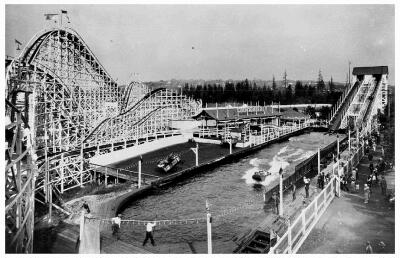 (Vancouver Public Library Photo #11691) Near Center is a Missouri Mule in operation. To the right of the Dipper station is a carousel. Within a few seasons this area will house a SkeeBall game and a Whip after the park gets a Philadelphia Toboggan Company carousel. |
Tim Covell of Ottawa, Ontario located a Vancouver Public Library photo (below) dated November 1928 (1935 on another document) that shows no activity of any kind, so it's presumably off season. (This is likely, as most Canadian parks close after Labour Day.) There is an open-walled, covered building in the same location between the coaster and chutes ride, but it doesn't occupy the same size area. A portion of the old "Mule" layout is outside the building. It's unclear if this was a smaller, but covered "Missouri Mule" installation, or if the ride was removed and replaced with another. Inside, there is a shiny floor, so it may have been a dance pavilion or roller skating rink.
|
The Enclosure 1928 or 1935 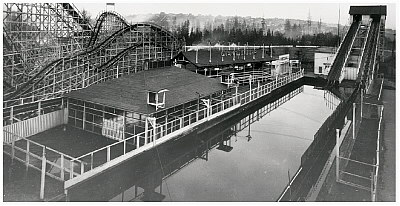 (Vancouver Public Library Photo #12265) Here is a closeup of the same area taken a year or more later. The Missouri Mule is gone and part of its area has been enclosed. Inside appears to be a shiny floor. |
Note the Skeeball and Whip
installations to the right of the coaster
station. The building under The Chutes
is for The Mysterious House.
|
Then too, the "Mule" attraction may have been replaced by bumper cars, as another 1928 photo from a different angle shows a "Skooter" sign next to that covered building propped against a railing. The "Skooter" name is usually associated with bumper cars. A later photo shows this name on that enclosure. However, the inside of the building appears to have no barrier, which would not represent a bumper car installation, so it's not certain that this was for such a ride.
Regardless, these photos mean that between the likely installation of The "Mule" for the 1927 season and the 1928 season, a permanent roof was installed over that area.
In 1928, the park received a permanent carousel: Philadelphia Toboggan Company #84. Built in 1928, it was a 4 row, with 2 chariots and 66 animals, of which 42 were jumpers. It was installed in an enclosed building near the former Machinery/Manufacturers' building, by then, The Transportation Building.
|
The new building for the carousel is
shown here beside The Greyhound
Racer track. To the right is the
Manufacturers' Building, while in the
background can be seen part of the
Baby Dipper structure.
The concessions at the bottom are
left to right: "Walking Charlie",
"Rifle Range", and beverage and
food outlets.
|
Carousel Building 1928 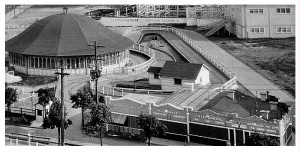
|
This unit would only stay in the park until 1933 or 34, when it was sold to Palace Playland, Maine. Why this was done is unknown. It's especially odd when one considers that only a few years later, another carousel was purchased. Perhaps the park needed the money at the time due to low patronship during The Depression. The PTC carousel has made its way back to Canada, though -- it now may be seen at Canada's Wonderland.
Other rides and attractions in the late 1920s and early 30s included food concessions, Bingo (10 cents a game), "Walking Charlie" (likely a game), The "Happyland Railroad" miniature train, a Penny Arcade, shooting galleries (one called "Rifle Range"), "Skee-Ball" and a Mangels "Whip" (both located next to The "Giant Dipper" where the old carousel had been), and gambling wheels and slot machines. One photo (farther on), shows a kiddie ferris wheel. This is possibly a "Little Eli" model from The Eli Bridge Company. Seen too, is a small track which had an `S' curve as part of its oval layout. Called The "Greyhound Racer", this may have been for a "U-Drive" type of auto ride, such as the Traver "Custer Car". They were battery-driven autos. Note that this is just speculation. No photos show any such cars. Today's successor would be the faster, gasoline-powered go-kart.
|
Concessions 1930 
|
A man relaxes during a day of sparse
crowds. Behind him is a Bingo tent,
with a merchandise stand beyond that.
This path leads from the grandstand
which is out of frame to the right
and behind. Across the way from the man is
a Penny Arcade, and to its left is The
Mysterious House. In the background
is the entrance way to The Giant Dipper,
Skeeball, Skooter and Whip.
Note the up-ramp of the Chutes ride above.
|
Popular contests were for best bird, cat, dog, or rabbit. On the outdoor stage (same as the 1915 Vaudeville Stage?) appeared bands, beauty and swimsuit contests, daredevils, pageants, plays, and other acts.
It should be noted that a carnival company, West Coast Shows, apparently bolstered the midway during exhibition times, which is still the case today at Playland. The company now is "West Coast Amusements" -- a successor company to West Coast Shows?
Despite an increase from 200,000 visitors in the mid 1920s to 377,000 in 1936, Happyland Park did not do well after the Stock Market Crash, much of it due to bad management. It changed hands in 1932 from The B.C. Amusement Company (Happyland's parent firm) to the park's creditors. They operated the location under the business name of "Pacific Coast Amusements" with L. C. Thomas as President and J. K. Matheson as General Manager. There was no interruption of the midway operation.
Part of the increase in visitors was due to the closure in 1930 of New Westminster's fair, forcing that fair's exhibitors and patrons to switch to The Vancouver Exhibition, thus boosting the latter's status and attendance. New facilities were built or modified to handle this increase including the Pure Foods and Women's buildings, and a new Forum. This provided curling (10 rinks), hockey, and skating, -- all in an area called The "Renfrew Complex". The Forum boasted the largest artificial ice surface in North America.
Also, sometime in the 1920s or 30s a pool was built, but no date or exact location has surfaced yet. It may have been part of this expansion program. If it's the "Alberta Pool", shown in a 1930s brochure, then it was located at the waterfront. This area was known as Brighton Beach, but no reference has yet surfaced as to when it got the name or what year a beach was developed.
For 1934, there were Scottish dancers on the open-air stage and a gold-panning demonstration. That year's house raffle boasted an impressive two-story home.
1935 saw the start of the annual opening day parade through the streets of Vancouver. It featured clowns, drill teams, floats, and marching bands.
A dilemma occurred in 1935 when a heavy snowfall collapsed the Forum roof and a bitter dispute erupted between the VEA and city council as to who would pay for the repairs. In 1936, a VEA accountant embezzled $41,000. After this came out, yet another public protest occurred followed by another investigation, which coupled with the Forum roof debate, threatened to dislodge the VEA from their control of the exhibition. They quickly re-organized and diverted any action by city council. No reference has been found as to how the Forum repair was paid.
Much later, another row over The Forum would finally spell the end of the Vancouver Exhibition Association. A conflict would arise in 1973 between minor hockey and The Boat Show that year. It concluded with the provincial government taking over the exhibition and thus the dissolution of the VEA. By that year, it had existed for 66 years and comprised a 64-season run of the exhibition, save for five seasons during War II. Even then, the VEA had managed to hold some of their events at other locations.
By 1936, the fair and Happyland covered about 80 hectares. Items mentioned in a 1936 brochure include the aquarium, athletic track, indoor badminton and tennis (in The Horse Show Building), a bird sanctuary, dance hall, the Forum, golf course, restaurant, and zoo, plus 15 amusement devices on the midway. The grounds are described as being "well maintained with flowers, beautiful lawns, trim walks and paved roads, trees and other items tending to the beautiful".
These fenced-in grounds with hundreds of seats, were accessible as a free park outside of the exhibition times. Entertainment in the form of band concerts and horse racing was provided.
Although the brochure photo shows The Industrial Building (by then, The Women's Building), it was torn down that year (probably at the end of the season) because it had deteriorated so badly. It had originally been constructed quickly to be ready for the first fair in 1910 and was not built to last. The Women's exhibit was then moved into The Renfrew Complex. Be aware that the brochure is dated as 1936, but the photo may have been from a few years earlier.
|
Brochure Photo 1936 or earlier  At Lower Left may be seen The Manufacturers' Building, The Carousel Building, The Baby Dipper and The Women's Building. Above that is the racetrack and grandstand. (The black area at the bottom is there to hide the distracting brochure text and not an actual part of the photo.) |
Pacific Coast continued to expand the park and maintain it as best as they could under 1930s conditions. Some of the rides and attractions mentioned, or visible in photos of the time, are the "Baby" and "Giant Dipper" coasters, bingo, carousel, "Mysterious House" (located under The "Shoot the Chutes"), a rifle range, a "Swooper" (Sellner), and a "Skooter".
The "Skooter" may also have been the name of a swing ride similar to the more modern Chance "Yo Yo", and is not to be confused with the bumper car ride mentioned previously. This ride may have been a Goodings "Chain Swing", which had been introduced in 1923 or a Traver "Merry Mix Up", which was copied from the Goodings ride. Both units may be seen in the photo below. There is still some question as to whether the "Skooter" name is correct for this ride - research continues.
The "Swooper", made by Sellner was an elongated, oval ferris wheel on which 14 two-seat tubs were attached to "stilt" supports. These stilts held the tubs some distance (estimate of about two metres) away from the oval, which remained stationary in a horizontal position. The oval structure was similar to a modern "Zipper", only shorter. The tubs and their supports were pulled via steel cables along a track which traced the oval's outline. It was far enough above the base for the tubs to swoop down under it to near ground level. Because of the oval shape, four tubs could be loaded at once. Operation years and the name used by the park are not known, but the ride does appear in a 1928 photograph, as seen below. (For a full-view image of a "Swooper" ride, see the Sunnyside Beach Park article.)
|
Happyland Carousel Building 1928  |
To the left of the carousel building
is a kiddie ferris wheel and a "Swooper".
Visible behind the tree at the lower
left is a swing ride and what appears
to be a second unit to the right.
|
In 1936, the park received another permanent carousel: a refurbished Parker Toboggan, #119. Built in 1912, the unit had been in Texas and California before sitting idle at the Parker factory for 13 years. It had 36 jumping horses, 4 standers, and 1 chariot spread over three rows. Music was supplied by a 1925 Wurlitzer 146-B band organ. The ride was apparently installed in the existing carousel building.
A brochure from around 1938 mentions 15 rides, 12 new and entertaining games of skill, with "splendid" prizes. A map shows Hastings Park, Alberta Pool, and the Golf Course. The ad copy reads "Happyland: joy mecca for thousands, yearly Exhibition Grounds, Hastings Park". Listed are the "Famous Giant Dipper", Weekly Amateur Contests, The "Karette": sensational 1938 ride, new special kiddies' rides, and Celebration Dance Pavilion.
With the start of World War II in September 1939, the 1940s saw the park take on a role similar to that of two and a half decades earlier. The fair's parades, displays and entertainment all took on a military flavour, and patriotism was the theme. Many government displays encouraged the buying of war bonds or recruitment into various armed forces branches. The midway offered a "Nudist Village" side show and other risque presentations, along with The Freak Show which featured an alligator-skin man, a fat lady, a four-legged woman, and little people dwarves/midgets. Midway photos show a kiddie aeroplane ride (Herschell?), a carousel, the two coasters, a ferris wheel, a "Tilt-A-Whirl", "Shoot the Chutes", and another ride that may be a Traver "Merry Mix-Up" (perhaps The "Skooter", as mentioned earlier).
|
This is an unknown airplane ride on the
midway. It may be from Herschell.
In the background is a Chain Swing
type of ride and behind that is The
Baby Dipper coaster. At Upper
Right may just be seen the Chutes
building peeking above a tent top.
|
Happyland Midway 1940 
|
A major addition in 1941 was the Lipsett Indian Museum which took the place of the aquarium. Indian artifacts were donated by Edward and Mary Lipsett to The VEA. These are now in the collection of Vancouver's Centennial Museum.
Unfortunately, the pressure of war was greater this time around and the Vancouver Exhibition Association was forced by the federal government to vacate the grounds for 5 long seasons, with 1941 being the last year of the fair until 1947. As well, the exhibition took up a lot more room than it had during World War I, so the fair and the military could not easily share the same area as they had during the pervious war. Some Association events were held in Chilliwack over 100 kilometres away in conjunction with their annual fair, while The Exhibition acreage again became a military staging ground for storage, drill practice, and as a manning center.
One of Canada's embarrassments of the 20th century was the war- time displacement of Japanese-Canadians (among other nationalities). This was partly through fear of them siding with Japan, but racism cannot be ruled out. These citizens were forced into camps in British Columbia's interior. Hastings Park was used as the processing center by erecting a fenced-in area that was set up with sexually segregated dormitories, a hospital, recreational facilities, schools, and a store.
Conditions were poor, as they were only made for temporary purposes. Having been intended for animals only, many of the buildings smelled bad and had rodent and insect infestations. The women's dormitory had 10 showers for 1,500 and a trough for a toilet, while the men's had thousands crammed into double bunk beds that were barely a metre apart. Over 8,000 Japanese-Canadians passed through here in the spring and summer of 1942.
In 1944, The "Baby Dipper" roller coaster was removed to make way for more facilities and military parking.
In the summer of 1945 an accident apparently occurred in Vancouver with a ferris wheel. Supposedly, several people were killed. Ranulph Fiennes' book "Feathermen" refers to such an incident, but no details are given. Since the exhibition was not running that year, either this happened at another carnival setup, or perhaps the midway was open that year without the exhibition.
During the war, The VEA had made plans to stage a come-back with a bigger and better exhibition when hostilities ceased. The war ended in 1945 but it took over a year to get the grounds back into fair mode. Although the exhibition didn't run in 1946, an independent directory from that year shows there were 14 rides including the carousel, a funhouse walk-thru, 15 games, 2 refreshment stands, a shooting gallery, and a penny arcade. Also shown are picnic grounds and a ballroom. The rides count is down by one due to the destruction of The "Baby Dipper". Pacific Coast or The VEA likely submitted the directory information in anticipation of Happyland reopening in 1946. On the other hand, Happyland might have run without the exhibition for a summer.
The Association wanted a new look and feel for the post-war years and so renamed the fair "The Pacific National Exhibition". It was to be run on a much more professional level. Opening year 1947, saw a huge parade and attendance of 600,000. It also ran the first "Old-Timers" hockey game at The Forum. A new grounds entrance is shown in later photos and was likely built for this season. The Ex was back!
|
Happyland Midway Possibly 1947 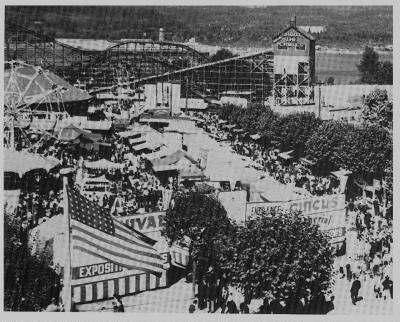
|
The Dipper and Chutes are seen in the background. The carousel building and two ferris wheels are visible among the tents. Note the 48-State American flag in the foreground. |
In February and March of 1948, The "Giant Dipper" was demolished to make way for the expansion of the racetrack from 800 metres to 1100. This expansion required a partial re-routing of McGill Street and the building of a retaining wall that reached 7 metres at its highest point. The new track would be pear-shaped and would use the existing grandstand, but with a new roof. Along with the coaster, two barns, the jockey's house and other buildings had to be removed to accommodate the track. The expected cost of $200,000 was to be shared by The Exhibition and the track concessionaire, Sam Randall, who was given a 20-year contract. These new track facilities would be refurbished only 12 years later after the merger of Landsdowne Park's Ascot Jockey Club with Exhibition Park's British Columbia Jockey Club in 1960.
Rolling stock from The "Giant Dipper" went to the Edward Bollinger & Son (Robert) coaster at The Western Washington Fairgrounds in Puyallup, Washington. That coaster had opened in 1936 and was refurbished in 1950 with new track, a new-style brake system and the "Dipper" trains.
Despite large crowds, Happyland apparently fell on bad times. Considering that the park hadn't operated for 5 years and that it lost its coasters, this would not be unusual. In 1948, the park owners petitioned The VEA to have their annual grounds license fee reduced. They complained that 35% of their revenue was lost due to the demise of those two rides.
Beginning in 1948, The Association began the "PNE Big Show" promotional. They booked American acts such as comedian and singer Jimmy Durante and ventriloquist Edgar Bergen into The Forum. Response was luke-warm. By the early 1950s, entertainment had switched to the Shrine/Polack Brothers Circus and despite some blatant American nationalism displays at times, it was a popular attraction into the 1960s. 1948 was also the first year for the Miss PNE Pageant beauty contest. Towns and cities in British Columbia were set up to have local contests. Each of those winners then entered the main contest held at The Exhibition Grounds.
The 1950s had aerial acts, a kiddieland, a snake show, and a new driving range. An undated advertisement shows the midway with a 12-tub Eli ferris wheel, a "Tilt-A-Whirl" (Sellner), and some games concessions. In the background is The "Chutes" ride, but no "Giant Dipper". Therefore, the photo would have been taken between 1948 (after The "Dipper" was torn down) and 1957 (before The "Chutes" ride was removed).
A popular event this decade was the Hobby Show with everything from model trains to The Toothpick Carnival. The latter featured amusement ride models made from toothpicks, two of which were a ferris wheel and a "Roll-O-Plane" (Eyerly).
|
Toothpick Carnival 1950 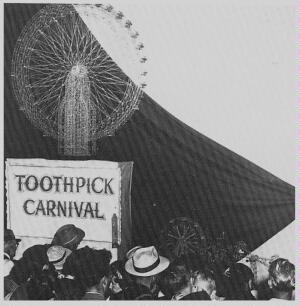
|
Here, large and small ferris wheels
are seen. At the lower right is a
Roll-O-Plane -- all made
from toothpicks and glue.
|
In 1954, the park hosted the British Empire and Commonwealth Games (now shortened to The Commonwealth Games). For this, a new facility called Empire Stadium was built to replace nearby Callister Exhibition Park. The latter was run by The PNE both during and outside of the exhibition. To build the new stadium, the golf driving range and course were closed and the land expropriated. Although, Empire Stadium opened in 1954, Callister Park would continue to be operated by the PNE until its usage was exchanged for an artificial surface put into Empire Stadium in 1969. Callister then became a city-run facility and eventually a green-space park.
Journalist Tom Hawthorn of Victoria, B.C. says: "Callister is located due west of the exhibition grounds, across Renfrew Street from the site of the Pacific Coliseum (which is on the site of the old Happyland). Callister was known as Con Jones Park in earlier days."
"A fairly substantial wooden grandstand was built and the park was the scene of soccer, lacrosse, baseball and football games. The minor-league Vancouver Maple Leafs called Callister home in 1938 and 1939, while industrial league baseball was played there for many years. I believe the grandstand was torn down in 1971. The 1.4-hectare park, since returned to ordinary green space, is bounded by Renfrew, Oxford, Cambridge and Kaslo streets."
During the 1954 games, Roger Bannister competed there. Just months earlier he had become the first to run a mile (about 1600 metres) in under four minutes. He again ran the course in under 4 minutes, as did second-place Australian competitor, John Landy, running only .8 seconds behind Bannister at the finish.
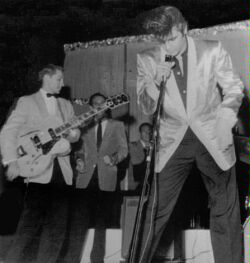 The new stadium allowed Vancouver to acquire a football
franchise that year and in 1955 it hosted The Grey Cup for the
first time. The facility would be used for sports and other
displays over the years. These included concerts of popular artists.
A small, covered stage would be erected for performers and their
equipment. Elvis Presley was at Empire with his band and The
Jordanaires in August 1957. This was one of only three concerts he
ever gave outside of The United States. The event was marred when
fans wanting to get closer to Presley, broke down barriers to get
to the stage. After the show, they damaged the temporary structure
when too many mounted it trying to again get close to their idol.
The new stadium allowed Vancouver to acquire a football
franchise that year and in 1955 it hosted The Grey Cup for the
first time. The facility would be used for sports and other
displays over the years. These included concerts of popular artists.
A small, covered stage would be erected for performers and their
equipment. Elvis Presley was at Empire with his band and The
Jordanaires in August 1957. This was one of only three concerts he
ever gave outside of The United States. The event was marred when
fans wanting to get closer to Presley, broke down barriers to get
to the stage. After the show, they damaged the temporary structure
when too many mounted it trying to again get close to their idol.

![]() Another anecdote regarding the stadium is that The Beatles played
there for 20,261 fans on August 22nd, 1964. This was during their
first full-fledged North American tour. (They had played a few dates
in the United States earlier that year.) It was their first concert
ever in Canada. There is a filmed record and also a bootleg album
"The Beatles -- Vancouver 1964". The bootleg came about because the
band was flying to the locations on the tour where upon each venue
would provide production (sound and lighting -- and barely adequate
at best), save for the band's stage equipment, which travelled with
them. The Beatles were illegally taped from the house sound system
that night and it, plus parts of a CKNW radio broadcast of the
event, were used to make the LP.
Another anecdote regarding the stadium is that The Beatles played
there for 20,261 fans on August 22nd, 1964. This was during their
first full-fledged North American tour. (They had played a few dates
in the United States earlier that year.) It was their first concert
ever in Canada. There is a filmed record and also a bootleg album
"The Beatles -- Vancouver 1964". The bootleg came about because the
band was flying to the locations on the tour where upon each venue
would provide production (sound and lighting -- and barely adequate
at best), save for the band's stage equipment, which travelled with
them. The Beatles were illegally taped from the house sound system
that night and it, plus parts of a CKNW radio broadcast of the
event, were used to make the LP.
This concert too, saw fans attempt to rush the stage. Some managed to buckle the stadium gates and spring them open early in the show, but were prevented from going farther by police and stadium staff. The gates were quickly secured. Another rush happened at the conclusion of the Beatles' approximately half-hour set. Many were hurt when pinned against the barrier fence. The band, being used to such antics, quickly exited after the last song and were whisked to the airport where their private plane awaited to take them to their next day's show in Hollywood, California.
Despite all this improvement and expansion, Happyland struggled, even while the PNE did well. The exhibition was becoming more entertainment and industry oriented while the agricultural emphasis of it shrank. Perhaps the cost of entertainment cut into peoples' carnival money, or perhaps it was again bad management, but Happyland discontinued operations after the 1957 season. Some of the remaining rides were the Parker carousel, a "Spitfire" (Hrubetz ?), and some kiddie rides. The "Shoot the Chutes" ride was torn down. It may have been the last surviving example of this model of ride, as most parks had torn theirs down decades earlier. Certainly, it was the final one existing in Canada. Today, the ride has been revived in modern versions like "Timberwolf Falls" at Canada's Wonderland.
|
The up & down ramps are gone,
leaving just the main building. Note
the concession building at the right
with an edge of a Coca Cola sign
visible.
|
Shoot the Chutes
Demolition 1957 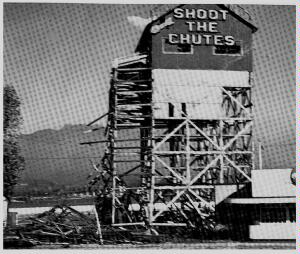
|
Burrard Amusements Limited was formed to build a new midway to be located diagonally across the park from Happyland in the southeast corner next to Empire Stadium. This would become today's Playland. Burrard had better resources than the ailing Happyland and would be able to put in a roller coaster which would bolster patronage. They hired Happyland employees and purchased several of its rides, including the Parker carousel. One of the three partners, Robert Bollinger, had his employees at his Oaks Park in Portland, Oregon U.S.A. refurbish the ride. He had a shop there to take care of the rides he owned that were located in other parks and in his travelling show. For protection from the elements, the Parker unit was placed at Playland in a new enclosed building shaped like a Mexican hat. The old carousel building was demolished.
Robert also owned a company called Fun-Tastic Rides and often brought in rides to Playland during The Pacific National Exhibition operating period to bolster the attractions list. In 1978, when Playland was acquired by The PNE, the carousel building was removed to show off the antique ride. Unfortunately, this allowed for deterioration and the ride was sold in 1990 to Burnaby Village, which had opened in 1971 as a museum. The carousel has been restored and began to give rides once more in March of 1993.
Today, on the site of Happyland is a parking lot and the 15,000-seat Pacific Coliseum, completed in the late 1960s. Empire Stadium was torn down in the early 1990s to become more sports fields.
Next to the present-day Exhibition Park, remains an area of Hastings Park. This is across the street from the PNE and since Happyland and the fair were placed on land that had once been part of Hastings Park, it is why Happyland had often been referred to by that name.
|
Thanks to Dianne Bollinger of Portland, Oregon for providing
Happyland's closing year and details of the carousel's history, as well
as for submitting the 1930s "Baby Dipper" Midway photo. Thanks also to
Dianne for clarifying the Hastings Park, Happyland, and Playland locations.
(Dianne was married to Robert Bollinger until his death in 2004.)
|
Return to the
Closed Canadian Parks Index
